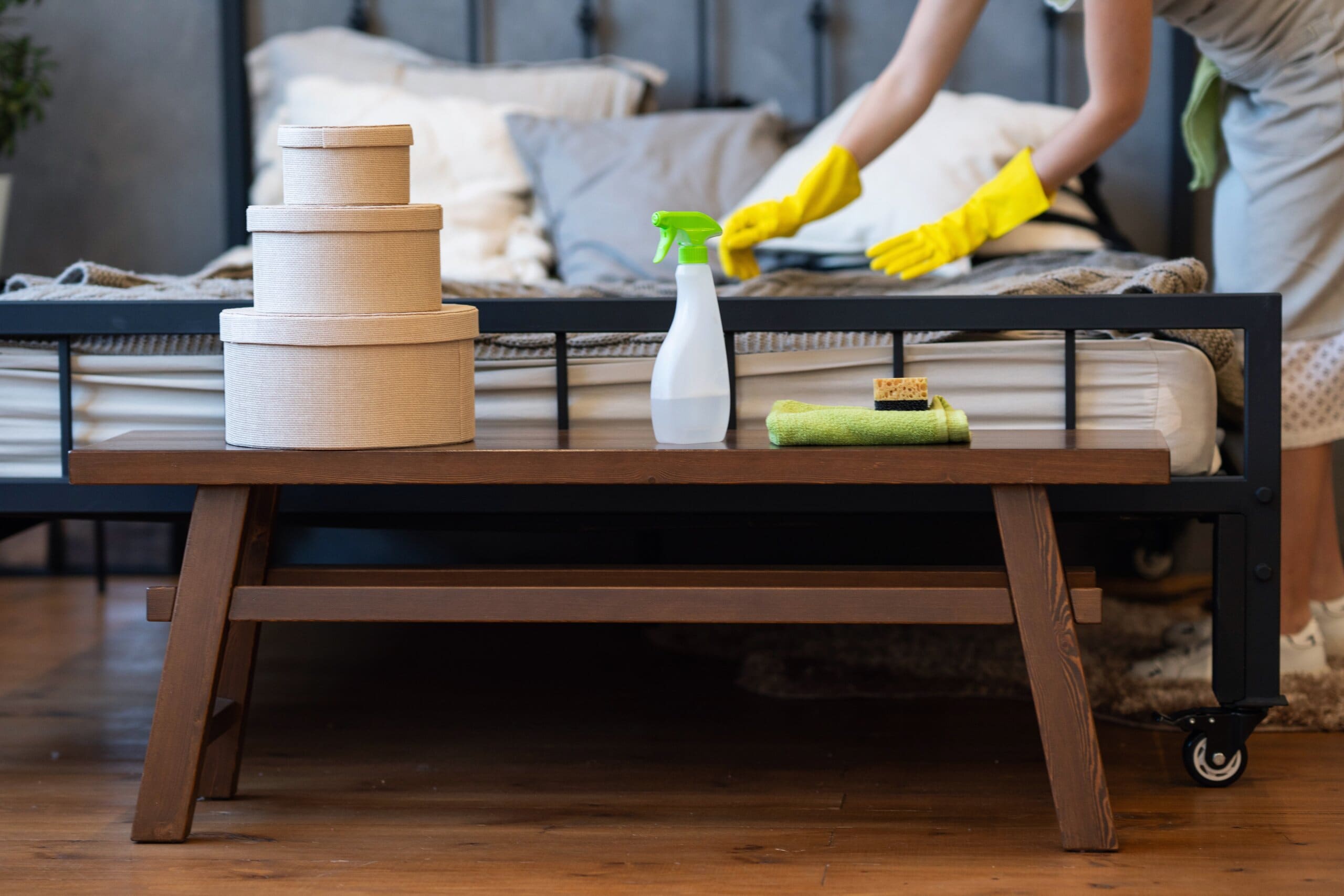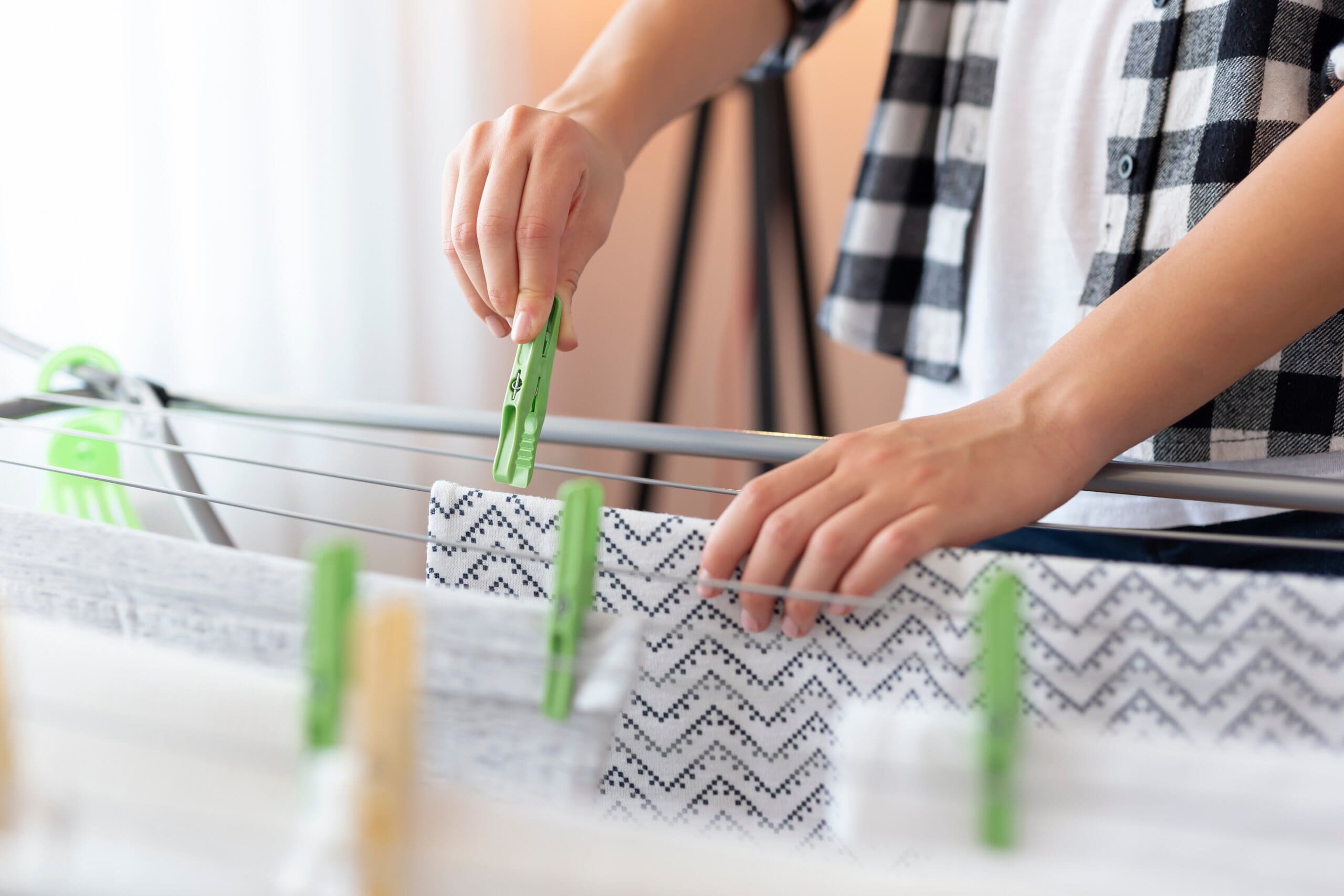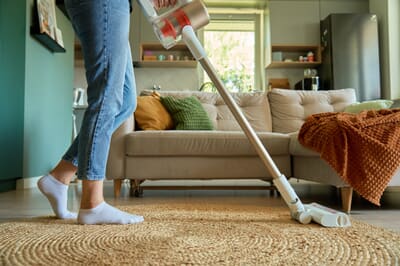#SundayReset has over 247.8K posts (and growing) on TikTok and is a hugely popular trend for the #CleanTok fans (CleanTok is a term searched on TikTok for videos featuring deep cleaning inspiration, tips, and before-and-after clips). But how can you create the perfect Sunday reset routine to truly optimise your weekend cleaning? We'll take you through what a Sunday reset is, why it's important, and how to nail it every time.

What is a Sunday reset?
A Sunday reset is a practice of cleaning, organising, or tidying your home on, you guessed it, a Sunday. It's likely that you use your Saturdays for fun weekend activities, and then spend Sundays sorting your home out, finishing up the chores you didn't get time to do throughout the week. By planning your Sunday reset routine, however, you can get these jobs done quickly and still have time to enjoy a relaxing Sunday before the work week begins.
Why should you do a Sunday reset?
A Sunday reset can be a beneficial way to unwind and uplift your mood, especially when the Sunday blues arrive. One study revealed that individuals who practiced mindfulness while washing dishes, savouring the soap's aroma and the overall experience, reported a 27% reduction in nervousness and a 25% improvement in "mental inspiration."
Of course, on a Sunday, an essential chore is washing your bedding. While the idea of fresh sheets on a Sunday is exciting to many, it's crucial not to postpone all chores until the weekend, potentially overwhelming you with tasks on a precious weekend day.
According to Martin Seeley, MattressNextDay CEO and Sleep Expert, "Distributing your chores across the week allows for smaller, consistent cleaning sessions instead of larger, less frequent ones that can overwhelm your weekends. Breaking tasks into smaller increments not only maintains a tidier living space but also minimises the stress associated with extensive cleaning sessions.”
We’ve outlined steps below that should take no more than 45 minutes, meaning you can still enjoy your weekend without overloading it with chores.
You should make the bed between 3 and 5pm
The optimal time for a Sunday reset of your bedroom is between 3-5 pm, aligning with the period when people typically experience Sunday blues. So, by doing it at this time, you can distract yourself from any negative feelings and, instead, experience the positive outcomes of a tidy space.
MattressNextDay advises stripping your bed in the morning, letting the mattress air throughout the day, and making the bed between 3-5 pm.
Martin Seeley, Sleep Expert and CEO of MattressNextDay explains, “Once a week, you should be pulling back your bedding and letting your mattress air. This gives your mattress the chance to spring back into shape, whilst evaporating any excess moisture.”


12-step Sunday reset routine
For the most effective and efficient Sunday reset routine, follow these expert-approved tips:
1. Do the bulk of your clothes washing earlier in the week
Wash the majority of your clothes on Mondays and Wednesdays to avoid the Sunday chore rush. This ensures you only need to wash your bedding on a Sunday, freeing up a lot of your time, and leaving you with a more manageable laundry schedule.
You could also set a day for each wash load. For instance, Monday is darker clothing, Wednesday light clothing, and so on, so you have an established routine that others in the house can follow.
2. Consider washing during off-peak hours
Wash during off-peak hours (typically between 10 pm and 8 am) to save on energy costs. While not everyone can manage before 8 am, check with your energy provider for a cheaper running time that suits your routine.
3. Skip making the bed on Sunday morning
Remove your sheets on Sunday morning but don’t make your bed straightaway. It’s important that you leave your mattress to air before changing the sheets. As you sleep, you sweat and moisture gets trapped in the bedding and, therefore, your mattress, duvet, and pillow. If you make the bed straightaway, that moisture can get trapped under the new bedding, allowing bacteria to build up. The best thing you can do is leave your bed to breathe for a few hours, ensuring that the moisture dries.
If your bedding items also vary in color, use the morning to separate them into distinct piles. Pre-plan in the week to determine if there are additional clothing items, throws, or towels that could be washed to make the most of your laundry cycle.
4. Wash at 60 degrees for optimal freshness
Washing at 60 degrees is, usually, recommended for cleaning bedding and towels to kill bacteria. Consider a strong detergent as well, as the temperature alone does not kill bacteria.
However, doing so can increase the cost of your wash by almost half than it would 40 degrees, so ensure you can afford the added cost.
5. Consider your options when drying your linen
Choose the right drying method to align with your budget and environmental concerns. Tumble drying is quick but expensive. Plus, repeated use of the tumble dryer on your bedsheets can affect their lifespan and even yellow them the more you use.
A heated airer or dryer can be an alternative in colder weather. Opt for models that come with a cover for enhanced efficiency.
In the summer, the most environmentally friendly and budget-conscious option is to place your washing on the line. Plus, the ultraviolet rays of the sunlight will remove any bacteria and also bleach your sheets, which is extra beneficial for those with white sheets.
However, be mindful that if you suffer from allergies, pollen may be present in the air. Check the pollen levels on a weather app to ensure it won't contaminate your freshly washed sheets, causing discomfort during the night.

6. Dust before you hoover
While your washing machine is in action, take the opportunity to hoover and dust your bedroom. This prevents dust particles from settling on your freshly cleaned bedding. We recommend dusting first to prevent dust particles from landing on your recently hoovered/cleaned floor or furniture.
Martin Seeley, MattressNextDay CEO and Sleep Expert said: “When well cared for, a clean mattress can last at least eight years. To keep it in tip-top condition, you should wash your duvet cover and bedsheets once a week to eliminate sweat and other residues from building up.
“To protect your mattress further, you should also let your mattress air for 30 minutes when changing bed sheets. Household dust mites love the warmth of your bed, so cooling it down helps eliminate them.
“Finally, you should vacuum your mattress every month to remove dead skin and other debris. Make sure to do this delicately and on a low setting as heavy-handed vacuuming could damage the ticking or outer covering of your mattress.”
You should also dust hard surfaces, including faux plants, using a duster or paintbrush. For fake plants, start at the top and work your way down to prevent spreading dust.
7. Don’t forget about your light switches
Light switches and lamps are commonly forgotten about when it comes to cleaning but it’s these kinds of touchpoints that can harbour the most germs and bacteria. In fact, a?study?discovered that the average light switch is crawling with 217 bacteria types per square inch; including faecal matter and E.coli – which is worse than the average toilet seat.
However, cleaning a light switch is super easy. Given that it’s electronic, you should never add the liquid directly onto the plug socket but instead onto a microfiber cloth. For similar reasons, make sure it’s only damp, not wet. You should then wipe rigorously to remove any sticky fingerprints, before using a dry cotton tip to get into the nooks and crannies of the actual switch. ?
8. Deep clean your bedroom carpets
Carpets and rugs in the bedroom can become clogged with dust and dirt, particularly if you walk through your room with your shoes. Not only can this make your room smelly and stuffy but research shows that it can impact the airflow of your room. This not only makes it harder for you to fall asleep at night but it can trigger allergy symptoms, or make you more prone to snore.
You should, therefore, hoover your bedroom carpet on a weekly basis and give it a deep carpet clean every Spring and Autumn. You can do this with a carpet cleaning machine, or if you’re on a budget, you can create a homemade mixture of one part distilled white vinegar with three parts of cold water in a spray bottle. You should then spray the solution onto the carpet until it’s very damp before letting it air dry. You can speed this up by using fans or opening your doors and windows.
9. Get under the bed
Depending on your bed frame, it can be relatively easy to hoover under the bed. However, if you have a divan bed, it is typically trickier than simply running the vacuum underneath for a once-over. It's essential to take the opportunity to hoover under the bed to prevent the accumulation of bacteria, dust mites, and various harmful pathogens.

10. Don’t forget the headboard
If you have a hard-surfaced headboard, ensure to dust it while the bed linen is in the washing machine to avoid brushing the dust on your fresh sheets. For fabric headboards, spray an even distribution of fabric freshener on the headboard, such as Fabulosa, and stroke it in before using a vacuum cleaner to remove the liquid.
Also, consider a monthly deep clean using baking soda. Apply a small amount to a damp cloth, working it into the fabric, before letting it sit for a few hours and removing any residue with a vacuum cleaner.
11. Use a tennis ball and sock to make your lumpy pillows fluffy again
To make your bed feel like one from a five-star hotel, you should also fluff your pillows. We recommend doing this daily (and certainly when revamping your bed on a Sunday). To do this, you just need to pick it up, hold the left and right sides of the pillow, and compress and decompress.
If your pillows are particularly lumpy, place them in the dryer with tennis balls inside a clean sock on the lowest setting for 30 minutes to restore fluffiness. If you want the volume of pillows, similar to that of a hotel bed, we recommend popping three pillows on the bed.
12. Finally, change the sheets after you have refreshed the bed
Put on the fresh sheets in the afternoon once they are fully dry and fluffy. We recommend using breathable materials for your bedding, such as cotton, that help regulate your body temperature and stop you from overheating, particularly if you tend to sweat a lot at night.
Finish off your Sunday reset routine by following our tips on how to make your home smell good all the time.
Once you've completed your Sunday reset routine, congratulate yourself on a productive afternoon and enjoy the rest of your day! Relax by reading our guides on the Trending Bedroom Ideas for this year, or wind down with our expert-approved Ultimate Bedtime Routine.





